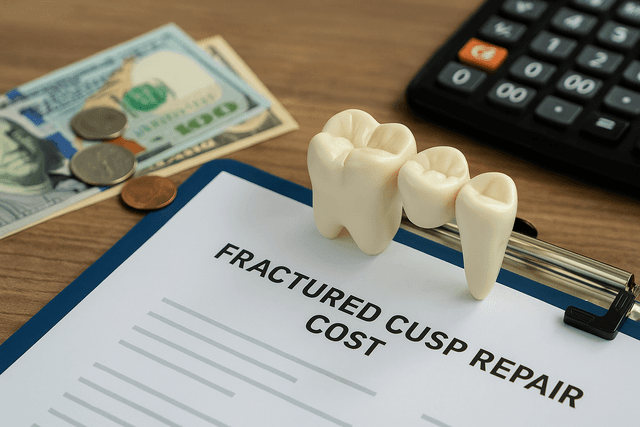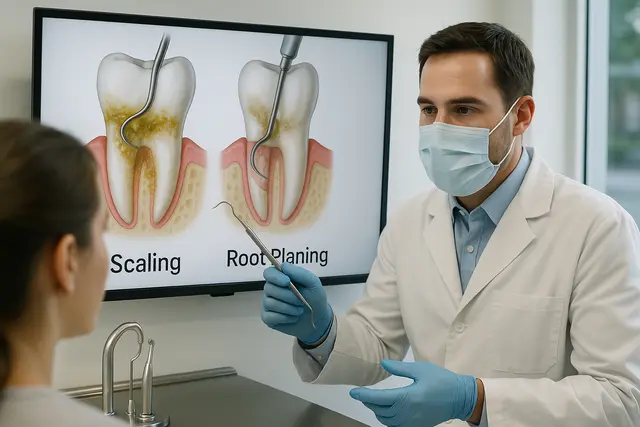General Dentistry
8 min read
May 20, 2025
How Much Does Fractured Cusp Repair Cost? Full Price Breakdown
Biting into something hard and suddenly feeling a sharp edge in your mouth? You’re not alone. Chipped, cracked, or fractured teeth happen more often than you'd think, and while the damage might look small, the repair bill can be anything but.

So, you bit down on something crunchy, or maybe you didn’t even notice, and now a piece of your tooth is missing. Maybe it feels jagged. Maybe it aches. Either way, there’s one question rattling around louder than the chip itself: How much is this going to cost me? Whether you’re dealing with a fractured cusp, a clean break, or a subtle but sinister crack, tooth repair doesn’t just hit your enamel, it can hit your wallet too.
Let’s walk through what a fractured cusp really is, how dentists repair it, and most importantly, what those repairs cost in the real world.
First: What Exactly Is a Fractured Cusp?
A fractured cusp is one of the most common types of cracked teeth. It usually happens when the pointed part of your tooth, the cusp, breaks off due to a crack or trauma. This is especially common in molars because they take the brunt of your chewing force. Unlike a vertical root fracture, which can split the tooth into two parts and often means extraction, a fractured cusp is usually more forgiving. But “forgiving” doesn’t mean “ignore it.”
While it might not always be painful at first, this kind of fracture can expose your dentin or pulp, leading to sensitivity, deeper decay, or even the need for a root canal if you wait too long.
The Repair Game Plan
Let’s talk solutions. The type of repair your dentist recommends depends on the extent of the damage, where it is, and how much of your tooth is still intact. There’s no one-size-fits-all dental procedure when it comes to cracked or chipped teeth, but here are the most common approaches:
Dental bonding or a filling: Good for small chips or surface-level damage.
Dental crown: Needed when a large part of the tooth or cusp is gone.
Veneer: More common on front teeth where cosmetics matter.
Root canal treatment and crown: If the fracture exposes or irritates the pulp.
Tooth extraction and dental implant: A last resort if the fracture is too deep.
Some of these fixes are quick. Others take multiple visits, especially when you're looking at crowns or implants. But the longer you wait to fix a chipped tooth, the more complicated and expensive the repair might get.
The Chip: Not All Are Created Equal
Not every chip is dramatic. Some are so small they’re called craze lines, tiny cracks in the outer enamel that don’t need repair at all. Others are minor but rough enough to snag your tongue or irritate your gum.
The deeper the chip or crack goes, the higher the risk it reaches the pulp or affects the tooth structure. That’s when root canal therapy or even extraction may be necessary. So if your chipped tooth looks small but feels off, don’t play tough. That’s your cue to book an appointment.
Tooth Repair 101: What You’re Really Paying For
Now let’s get to the meat of it, how much does fractured cusp repair cost? Like any dental work, the answer is a frustrating “it depends.” But we’ll break it down with average price ranges, so you’re not flying blind.
Dental bonding: $100 to $400 per tooth. Best for small chips and cosmetic touch-ups. It uses tooth-colored resin that blends right in, though it may wear down over time.
Tooth-colored filling (composite resin): $150 to $500 per tooth. Good for moderate chips that don’t impact the chewing surface too much.
Porcelain veneer: $900 to $2,500 per tooth. Often used to fix a chipped front tooth with a flawless finish. Not usually covered by insurance.
Dental crown: $900 to $1,600 per tooth. Essential for fractured cusps or cracks that compromise the chewing surface. This covers the whole tooth and restores full function.
Root canal and crown: $1,200 to $2,500 total. If the crack reaches the pulp, a root canal may be necessary before placing a crown.
Tooth extraction and dental implant: $3,000 to $6,000 per tooth. The nuclear option. Used when a tooth is broken beyond saving, like with a vertical root fracture.
These prices can vary based on your location, the materials used (resin vs porcelain vs zirconia), and your dentist’s experience.
Fix a Chipped Tooth Before It Gets Worse
Repairing a cracked or chipped tooth might feel optional if it’s not causing pain, but delaying treatment is a gamble. That little chip can turn into a fracture. That fracture can reach the pulp. Then suddenly, you’re not looking at bonding anymore. You’re looking at root canal treatment or a full-blown extraction.
The earlier you catch it, the more likely your dentist can save the tooth with a simple, lower-cost fix.
Cracked Teeth: When It’s More Than a Surface Issue
Not all cracks are visible. You might feel toothache pain when chewing, but not see anything in the mirror. These are warning signs of deeper damage, like a vertical root fracture or cracks below the gumline. These types of tooth fracture require prompt dental care by an oral surgeon, sometimes involving complex treatment and diagnostic x-rays.
In those cases, the cost to fix a chipped or cracked tooth might go up, especially if surgical intervention is needed.
Cost to Fix a Chipped Tooth: What Affects the Price?
Several things influence the final repair costs:
Extent of the damage: A minor surface chip is one thing. A full fracture of the cusp is another.
Tooth location: Repairing a molar is usually more functional and less cosmetic. Front teeth? They need to look perfect.
Materials: Porcelain costs more than resin but lasts longer and looks more like your natural tooth.
Dental insurance: Plans vary wildly. Some cover fillings and crowns, but many won’t touch veneers or implants.
Dentist experience and location: A Beverly Hills cosmetic dentist will charge more than a general dentist in a small town.
The cost to fix a chipped tooth or fractured cusp can range from a few hundred dollars to several thousand, depending on these factors.
The Hidden Cost of Delaying Treatment
Here's the part many patients don’t consider. Waiting to repair a chipped or cracked tooth doesn’t save money. It usually makes things worse, and more expensive.
A small chip becomes a deep fracture.
A mild ache turns into pulp inflammation.
A filling becomes a crown.
A saveable tooth becomes an implant.
In short: the cost to fix a chipped tooth early is almost always less than the cost of complex treatment later.
Dental Insurance: Will It Help or Just Tease You?
If you have dental insurance, you might be wondering: Will it actually cover this?
Some plans will cover part of the chipped tooth repair cost, especially if it’s deemed medically necessary. That usually includes dental bonding, crowns, and root canal treatment. But cosmetic procedures like veneers? Probably not.
Also worth noting: dental insurance plans often have an annual cap. So if you already used up your coverage for cleanings, X-rays, or past work, that crown might be coming out of your pocket.
Always consult with your dentist and insurance provider before starting. A good office will help you submit the right codes and give you a clear cost breakdown before they break out the drill.
Dentist or DIY? Please Don’t Google That
If your tooth is broken and you’re tempted to patch it up with dental wax or superglue, don’t. Temporary measures like over-the-counter dental wax can be helpful in a pinch to protect the area from food and air, but they’re not a solution.
You’ll need a dental professional to assess the crack, clean the area, and determine the safest type of treatment. Every day you wait, bacteria have a better shot at getting in. And no, that TikTok hack with the nail file won’t fix a chipped tooth. It’ll just damage your tooth enamel even more.
Types of Chipped Teeth: Not All Chips Need the Same Fix
Let’s get specific. Here are the most common types of tooth damage, and the usual response:
Minor enamel chip: Often handled with smoothing or dental bonding.
Moderate chip or fracture: Needs a resin filling or crown to restore strength.
Severe fracture into the pulp: Requires a root canal and crown.
Split tooth or vertical root fracture: Extraction may be necessary, followed by a dental implant.
Knowing the type of chipped teeth you’re dealing with gives you a better sense of what to expect and how much it may cost to fix.
Can a Broken Tooth Be Fixed?
Absolutely, if you catch it early enough. Even fractured teeth can be restored with the right dental care. Dentists today have a wide toolbox: composite resin, porcelain crowns, dental implants, and more.
The key is getting in quickly. The longer you wait, the more likely it is that the damage will spread below the gum or down into the root. And that’s when options start to disappear, and costs start to spike.
Let’s Talk Numbers: Chipped Tooth Repair Cost in a Nutshell
Here’s a rough price recap to give you a sense of what to budget:
Dental bonding: $100–$400 per tooth
Filling (composite): $150–$500 per tooth
Crown: $900–$1,600 per tooth
Veneer: $900–$2,500 per tooth
Root canal with crown: $1,200–$2,500
Extraction + dental implant: $3,000–$6,000
That’s why prompt dental care matters. What starts as a $400 fix can balloon into a $6,000 saga.
Final Word: Your Smile’s Worth Fixing
A cracked or chipped tooth isn’t just an inconvenience. It’s a call for action. Your tooth may look okay from the outside, but beneath the surface of the tooth, there could be decay, pulp damage, or a fracture waiting to get worse.
The good news? There’s almost always a way to fix it, and make it look and feel like your natural tooth again. Whether it’s bonding, a dental crown, or even an implant, the goal is the same: restore your smile, protect your health, and avoid worse problems down the line.
So if you’re staring at a cracked molar or a chipped front tooth, don’t wait. Call your dentist, ask for a full cost breakdown, and save that tooth while you still can.
What Is a Fractured Cusp and How Serious Is It?
A fractured cusp occurs when the pointed part of a tooth, usually a molar, breaks off due to trauma or a crack. It’s common and typically less severe than a full vertical root fracture, but it shouldn’t be ignored. If untreated, it can expose the inner layers of your tooth, leading to sensitivity, infection, or even the need for a root canal.
How Much Does It Cost to Fix a Chipped or Fractured Tooth?
The cost varies based on the extent of damage and the repair needed. Bonding may cost $100–$400, while a filling runs $150–$500. A dental crown can cost $900–$1,600, and if a root canal is necessary, total costs can reach $1,200–$2,500. Severe fractures requiring extraction and implants may cost $3,000–$6,000 per tooth. Your location, dentist’s experience, and insurance coverage all play a role.
Can You Fix a Chipped Tooth at Home?
No, DIY repairs are not recommended. While dental wax can temporarily protect a chipped tooth, only a professional can assess the severity and provide proper treatment. Using glue or filing tools can lead to further enamel damage, infection, or more expensive dental problems down the line.
Will Dental Insurance Cover the Cost of Repair?
Dental insurance may cover medically necessary repairs like fillings, crowns, or root canals. However, cosmetic treatments like veneers often aren’t covered. Keep in mind that insurance plans usually have annual maximums. It’s important to confirm your benefits in advance and work with a dental office that can provide a detailed cost breakdown.
Read Next
Related Posts

General Dentistry
How to Stop Nerve Pain in Tooth: Fast Relief That Works
Tooth nerve pain can be one of the most intense and disruptive types of discomfort. It often strikes without warning and makes everyday activities like eating, drinking, or even talking feel unbearable. Understanding what causes this pain and how to manage it effectively is key to getting fast relief.
4 min read
Sep 15, 2025

General Dentistry
Can a Sinus Infection Make Your Jaw Hurt? Understanding the Connection
Jaw pain can be unsettling, especially when it seems to appear out of nowhere alongside a stuffy nose or headache. Many people are surprised to learn that sinus infections can cause discomfort that feels like it’s coming from the jaw. Understanding the connection between your sinuses and jaw pain is key to getting the right treatment.
5 min read
Sep 15, 2025

General Dentistry
What Is SRP in Dentistry? A Complete Guide to Scaling and Root Planing
When it comes to dental health, most people think regular cleanings are enough to keep their smile safe. But sometimes, what’s happening below the gumline needs more attention. Scaling and root planing (SRP) is a treatment designed to address gum disease at its source, protecting both your gums and teeth from long-term damage.
5 min read
Sep 10, 2025
Don’t have time to research every dentist around you?
See why 30k+ patients trusted us